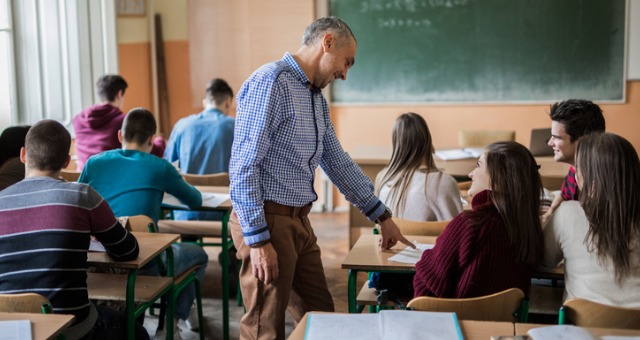Achieve Academic Success with Primary Science Tuition Singapore
Achieve Academic Success with Primary Science Tuition Singapore
Blog Article
A Comprehensive Guide to the Various Understanding Approaches in Main Science Guideline
The expedition of diverse learning approaches in primary scientific research direction provides an opportunity for instructors to improve student interaction and comprehension considerably. By analyzing hands-on learning methods, inquiry-based methods, and joint techniques, we can recognize efficient practices that satisfy numerous finding out styles. Additionally, the assimilation of innovation and separated direction plays a vital duty in fostering a comprehensive atmosphere. The concern remains: exactly how can these approaches be successfully implemented in the classroom to optimize their impact? The solution lies in a closer analysis of each approach and its ramifications for training science.

Hands-On Knowing Methods
Hands-on discovering strategies play a pivotal role in primary science instruction, engaging students in active exploration and experimentation. These methods allow students to interact straight with sensations and products, promoting a deeper understanding of scientific concepts. By utilizing manipulatives, models, and real-life experiments, educators develop a setting where pupils can observe, hypothesize, and evaluate their ideas.
Such techniques not just boost understanding however also grow essential reasoning and analytical skills. When students get involved in tasks like developing easy machines, growing seeds, or performing chemical responses, they are encouraged to ask questions and look for responses via their very own observations. This experiential approach assists to demystify intricate clinical principles, making them extra relatable and available.
Furthermore, hands-on understanding promotes collaboration amongst peers, as students usually operate in teams to carry out experiments or share searchings for. This team effort not only enhances their knowing experience yet likewise develops crucial social skills. Ultimately, incorporating hands-on methods in primary scientific research direction fosters a long-lasting love of learning and interest concerning the environment, laying a solid foundation for future academic searches in science and past.
Inquiry-Based Learning
Inquiry-based discovering is an instructional technique that urges students to ask concerns, explore phenomena, and build their very own understanding of clinical concepts. This technique changes the emphasis from traditional teacher-led direction to a much more student-centered experience, where students take the campaign in their educational journey. By promoting interest, inquiry-based knowing advertises much deeper involvement with the product, allowing students to explore topics in a significant context.
In method, this technique usually involves hands-on experiments, observations, and critical thinking activities that align closely with the scientific method. Pupils are urged to create theories, layout examinations, and examine information, which grows vital abilities such as analytical and analytical thinking. The function of the teacher in this framework is to help with expedition, leading trainees through the questions process while urging independent idea and cooperation.
Furthermore, inquiry-based discovering supports a feeling of ownership over the discovering process, motivating students to seek understanding actively. This approach not just enhances understanding of clinical concepts yet additionally promotes a long-lasting love for understanding, furnishing students with the abilities required to browse a significantly complicated globe.
Collaborative Discovering Approaches
Collaborative knowing techniques encourage students to engage in significant communications with peers, fostering a shared obligation for their instructional outcomes. In primary science direction, these approaches urge learners to collaborate to check out clinical ideas, address troubles, and conduct experiments (primary science tuition Singapore). By taking look at these guys part in group activities, students can take advantage of varied viewpoints, enabling richer understanding and retention of scientific understanding
One secret element of collective understanding is the focus on interaction abilities. Trainees have to articulate their thoughts, listen actively to others, and negotiate concepts, every one of which are essential expertises in both scholastic and real-world contexts. This social communication not only enhances their understanding of scientific concepts yet additionally advertises team effort and dispute resolution skills.
Furthermore, collaborative learning often leads to raised inspiration and interaction. They are more most likely to take ownership of their learning trip when students see the value of their payments within a group. Educators can facilitate this procedure by creating structured team tasks that straighten with curriculum objectives while offering guidance on efficient collaboration strategies. In general, including collective understanding techniques in primary science guideline cultivates a vibrant learning atmosphere that prepares students for future academic and social obstacles.
Innovation Combination in Scientific Research
The integration of technology in main scientific research guideline boosts learning experiences by offering ingenious devices and sources that sustain numerous training methodologies, including collaborative knowing - primary science tuition Singapore. right here The usage of electronic systems, simulations, and interactive applications permits pupils to involve deeply with clinical ideas, promoting an extra hands-on approach to learning
Virtual laboratories, as an example, enable learners to conduct experiments securely and successfully, advertising inquiry-based understanding. These devices can replicate real-world scientific scenarios, allowing students to envision intricate procedures that would certainly be challenging to duplicate in a conventional classroom setup. In addition, innovation promotes interaction and cooperation among students, as they can share searchings for and collaborate on projects via on the internet platforms.
Furthermore, multimedia presentations and instructional videos can improve lessons by accommodating diverse discovering styles, making abstract principles much more accessible. Information analysis devices also encourage students to accumulate and interpret clinical data, enhancing important believing skills. Generally, the strategic consolidation of technology in main scientific research instruction not just enhances interaction yet additionally prepares students for a technically innovative society, furnishing them with crucial skills for future clinical undertakings.
Distinguished Guideline Strategies
Distinguished direction approaches are important for attending to the varied needs of learners in main scientific research education and learning. These approaches enable educators to tailor their mentor approaches to suit differing abilities, interests, and discovering styles within the classroom. By utilizing set apart guideline, educators can develop a comprehensive atmosphere that cultivates involvement and boosts understanding of clinical principles.
One reliable approach is to make use of adaptable organizing, which permits trainees to work together with peers at similar skill levels or with varying viewpoints. This strategy motivates peer discovering and promotes vital thinking. Additionally, offering selections in jobs can equip students, allowing them to pick jobs that resonate with their interests while still fulfilling curricular goals.
Furthermore, incorporating tiered jobs is an additional useful technique. By designing jobs with varying degrees of intricacy, educators can ensure that all trainees are appropriately tested, no matter their proficiency. Making use of formative analyses to assess understanding more allows teachers to change their instructional approaches dynamically, guaranteeing that each student obtains the support they require.
Ultimately, applying distinguished instruction methods in primary science education not just enhances pupil learning end results but likewise grows a passion for scientific research, preparing trainees for future scholastic pursuits.

Final Thought
In recap, efficient key science guideline requires a multifaceted technique that encompasses hands-on learning, inquiry-based approaches, and collective strategies. The combination of technology and distinguished guideline additionally caters to varied understanding styles, promoting a setting conducive to exploration and essential thinking. By executing these approaches, educators can enhance trainee involvement and comprehension, inevitably supporting a long-lasting passion for scientific research and questions. Such comprehensive approaches are crucial for developing notified and interested future researchers.
The expedition of varied discovering techniques in primary science guideline offers a chance for teachers to enhance pupil involvement and comprehension dramatically.Hands-on understanding methods play a critical role in key science instruction, involving trainees in active expedition and testing.Inquiry-based learning is an educational technique that encourages pupils to ask concerns, examine sensations, and build their very own understanding of scientific concepts.Collective learning strategies equip pupils to engage in purposeful interactions with peers, cultivating a shared responsibility for their instructional outcomes. On the whole, incorporating joint knowing strategies in main scientific research instruction read this article grows a vibrant knowing setting that prepares students for future academic and social obstacles.
Report this page